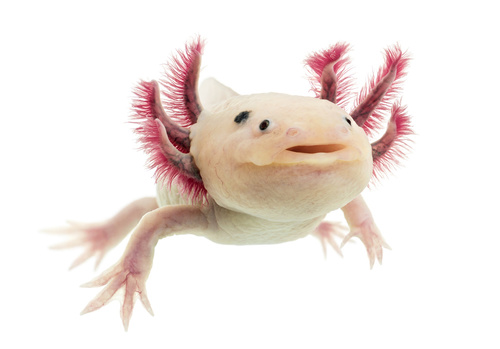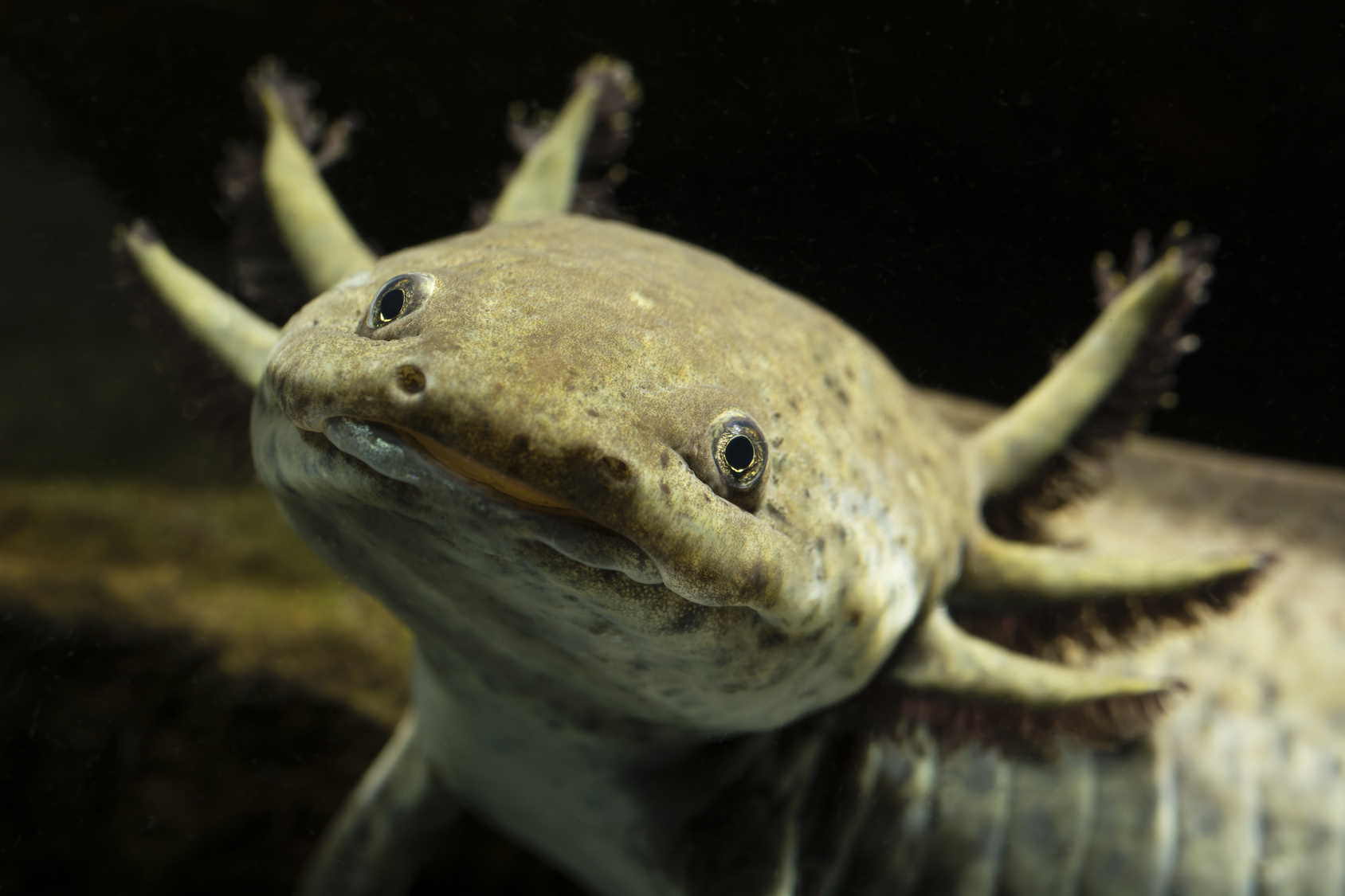Butterfly Koi
Are you looking for new carps (Cyprinus carpio) for your pond? Then you should definitely consider the Butterfly Koi. Read in this article the most important information on this beautiful Koi.

© Eric Isselée / stock.adobe.com
The Axolotl, the Mexican salamander, has been a real pet trend for a few years. Its friendly appearance and stand-out colouring make this animal a real eye-catcher for a unique home. Despite its apparent exoticism, a Axolotl is comparatively low-maintenance – learn all about it here.
The Axolotl is an anomaly amongst amphibians. This Mexican salamander primarily lives underwater and always remains in its larval stage. Instead of commencing metamorphosis, it reproduces in larval form. By doing so, the Axolotl isn’t a curious variation, but instead emerges in a completely natural manner. Alexander von Humboldt discovered the first specimen at the start of the 19th century and brought it to Europe.
An adult Axolotl is around 23 to 28cm in length, though occasionally they can also reach 30 to 40cm. However, such specimens are rare. The small dark eyes, delicate arms and fin-edged tail the animal uses to move in water catch the eye. Not least, the Axolotl’s flat head and wide mouth make it a very popular pet. On the face of it, it appears that the amphibian is constantly smiling – coupled with its dot-like dark eyes, it appears very friendly. The different sexes can be distinguished by the arch of the cloaca. It emerges slightly on males, but is flat on females.
Different Axolotl were bred in the previous century in order to make many distinct colours and shapes of the animal available to purchase. For instance, there are many albino Axolotls in aquariums in Germany. Other Axolotls mainly have dark, black or grey colouring. What is astounding with these creatures is how the organs and limbs grow again. For example, if a leg gets ripped or bitten off, it will fully grow back again after some time. Even the protruding gills can regenerate in case of injury. Axolotls can fundamentally be kept in an aquarium with other animals, but even though the body parts grow back, you should still avoid choosing aggressive fellow occupants to accompany your salamander.
Classic Axolotl found in nature are grey-black in colour. Besides, there are a number of colour tones that have mainly resulted from breeding. White and beige, gold and mottled are the most popular pets. The so-called wild-type is therefore somewhat atypical. Its skin is light green in colour and dabbed with dark spots. The biramous gills stand out from both sides of the head with small red fins. Copper-coloured Axolotls are relatively rare, whilst the axanthic Axolotl, which is occasionally completely colourless and appears largely transparent, is even rarer. In addition, there are some albino specimens with a metallic shine, mosaic-patterned chimera or “harlequins”. The latter is actually a whiting possessing a few cells that can form pigments. Through this, the typical “facial mask” develops in different shapes.
 © lapis2380 / stock.adobe.com
© lapis2380 / stock.adobe.com
The word Axolotl comes from the Aztec language Nahutal. “Atl” means “water”, whilst “Xolotl” is one of the Aztec gods. The translation of Axolotl therefore means water food or water monster. As the name suggests, the lakes of Mexico are the original home of these creatures. They can be found in the canals of Xochimilco and in the Chalco Valley surrounding Mexico City. It has been suggested that these salamanders also lived in other lakes at this altitude that have now dried out. Their special shape could have something to do with the volcanic origin of the region and its water system. A mere 0.3 animals per square metre live in Xochimilco nowadays. They prefer cold, oxygen-enriched water, hence they mainly settle in these lakes and are considered nocturnal in the wild. Since they are not found anywhere else in the world, you can easily get the feeling that they are creatures from a prehistoric age. It’s true that the Axolotl is a very ancient animal that already acquired a holy status in Meso-American culture. However, it was partly also used as food. Axolotl can still be found in Mexican fish markets to this very day.
The Axolotl is always on the lookout in order to cover its energy consumption. As soon as a small crustacean swims past, these hunters strike and put it right on their own personal menu. Besides, the salamander eats invertebrate animals like insect larvae and the spawn of other amphibians. It even eats its own descendants from time to time. As well, smaller fish can be their preferred food. When kept in a domestic environment, they are generally fed larvae and insects. For instance, mosquitoes, earthworms and flies are a real feast for amphibians. You’re best off feeding younger fish on a daily basis. For adults, it’s sufficient to give them food twice a week.
As previously mentioned, the Axolotl lives in cool, oxygenated fresh water. This should of course be reconstructed as well as possible in an aquarium. The water temperature should ideally be between 12°C und 20°C. If it falls below 10°C, these amphibians do not suffer any damage, but they do start to swim around the tank in a state of panic as soon as it gets above 24°C. The higher the temperature, the more their metabolism will be stimulated. Furthermore, in such cases illnesses that can ultimately lead to death can emerge. Temperatures from 1°C to 2°C are unproblematic for these animals.
The floor of the aquarium is lined with fine-grain sand. Stones that are too big can easily be swallowed, leading to fatal intestinal obstruction. Suitable base gravel can be easily purchased. The ideal grain size for these amphibians is 1 to 3 millimetres. A filter is absolutely essential for keeping an Axolotl, because they constantly enrich the oxygen in the tank along with a water pump. External filters are ideal, since few technical elements are visible in the tank and an excellent purification capacity is guaranteed. Despite this, it is important not to allow too much movement in the water, since this can also make these salamanders become stressed.
The Axolotl feels at ease in hard water with a pH of over 7. In water that is too soft, these animals can lose their colouration for a short time. This is fundamentally not dangerous, but can cause stress. If the taps only produce soft water, it can be be enriched with salts like sodium, potassium and calcium. pH values between 7 and 7.5 are ideal. The expanded comfort zone ranges from 6.5 to 8. There should be a maximum of 0.5 g of nitrites per litre in the aquarium. 25 milligrams are acceptable for nitrates.
The Axolotl copes very well with being kept on its own or as one of a pair. You should buy a sufficiently large aquarium if you have two adult animals. These amphibians only rarely get on well with other species. Fish tend to socialise less because they are predominantly viewed as food. When it comes to feeding time, you should definitely dim the lights below, since Axolotls are nocturnal creatures. The more Axolotls are kept in the same basin, the bigger it must be in terms of base area.
As a rule of thumb, you can use the following indications for the required aquarium size:
You should calculate 50 to 80 litres of “space” in the water for each adult Axolotl. The height of the aquarium is less significant, as you should instead focus on the aquarium being sufficiently large in terms of base area.
The aquarium itself should offer sufficient free space on the base for the fish, as well as a few retreat options (caves, roots) and the lighting should be quite dim. In order to maintain sufficient oxygen, it is recommended to purchase an external filter and possibly an oxygen pump too. Plants can also be kept with the Axolotl, though you should opt for robust plants like java fern, waterweeds and moss. Floating plants on the surface of the water can also be an excellent choice for the Axolotl aquarium, since the slight shadows don’t bother these animals.
Axolotls are fundamentally very robust animals. Due to their regenerative characteristics, severe injuries to the limbs seemingly don’t harm them. These amphibians can even easily regenerate parts of the brain and heart. No visible damage remains. What can prove dangerous to health are mainly excessive temperatures and resulting stress, overly powerful water circulation and high pH values. Too much acid in the water can lead to ammonia being produced. This has a toxic effect on these Mexican salamanders and invariably leads to their death in the long-term.
Parasite infections are not uncommon, whereby mainly crustacean gills can lead to severe inflammation. Ciliates in turn only cause severe illnesses when there are severe attacks on weakened animals. These are reflected by physical inactivity and loss of appetite. Flagellates appear in the colon and can cause mucus deposits and skin detachments amongst older, weaker animals. Infestation with one-celled mesomycetozoea should absolutely be avoided. They make blisters form on the skin that can no longer heal after they burst, therefore tightly-knit growths can emerge. There is no treatment for these parasites.
If kept in species-appropriate conditions, Axolotls can live to be very old. The average life expectancy is around 15 years. There are even some fish that reach the incredible age of 25. On average, the minimum age is between 8 to 10 years.
Are you looking for new carps (Cyprinus carpio) for your pond? Then you should definitely consider the Butterfly Koi. Read in this article the most important information on this beautiful Koi.
Radiantly colourful and somewhat aggressive towards other fish and conspecifics: The Siamese Fighting Fish is a remarkable creature that brings a dash of colour to any aquarium. With modest demands, this pet is incredibly easy to care for and very popular with aquaristics beginners. This article compiles the most important information about the Siamese Fighting Fish.
The Axolotl, the Mexican salamander, has been a real pet trend for a few years. Its friendly appearance and stand-out colouring make this animal a real eye-catcher for a unique home. Despite its apparent exoticism, a Axolotl is comparatively low-maintenance – learn all about it here.